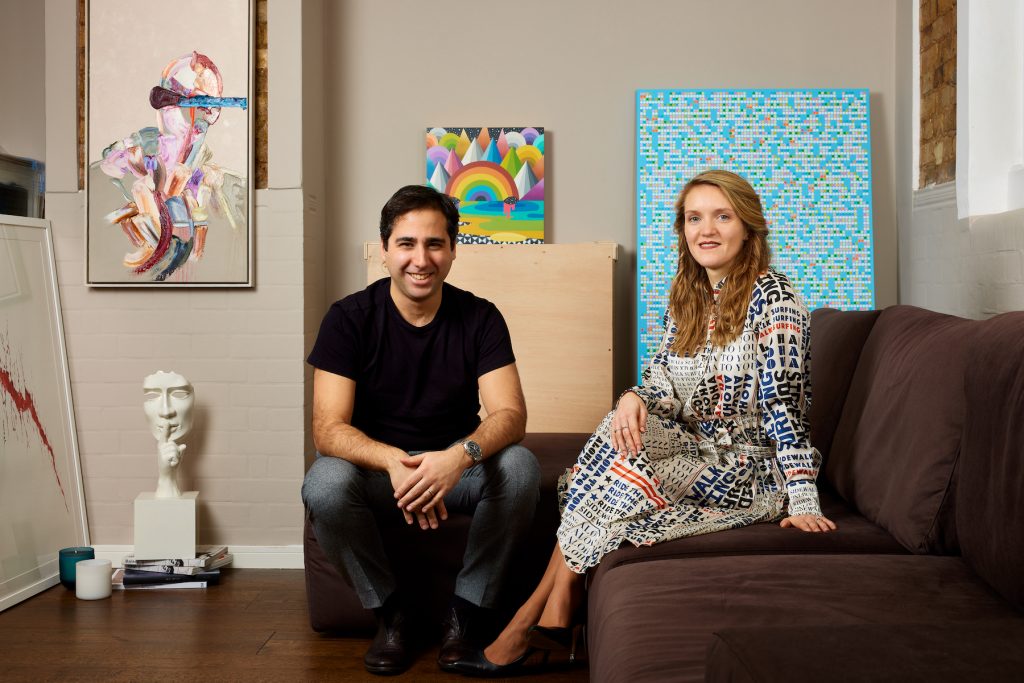Buyer's Guide
7 Questions for the Founders of Artscapy, a Collector-Focused Platform That Wants to Democratize the Art World
Collectors Alessandro De Stasio and Emilia De Stasio want to demystify the art market for collectors of all levels.

Collectors Alessandro De Stasio and Emilia De Stasio want to demystify the art market for collectors of all levels.

Artnet Gallery Network

Many art platforms set out with ambitions to democratize the art world, but Artscapy is convincing many art-world insiders that it’s the one to actually do it.
Founded by Alessandro De Stasio and Emilia De Stasio, two experienced collectors, Artscapy is focusing on collectors and their specific needs. In fact, the platform is based around responding to observations and problems the De Stasios encountered in their decade-long collector journey, and provides analytics and charting tools to provide collectors with insights into the value of their collection and its evolution over time.
Their platform also features a “collector-to-collector” marketplace, where each artwork listed for sale undergoes due diligence to make private sales transparent and safe.
The platform is also centered on the latest technologies and with the utmost regard for privacy: Artscapy uses end-to-end encryption technology to safely store and track information, and the quality and authenticity of the art is underpinned by certificates of authenticity and provenance on blockchain.
“We are on a journey to make the fine art market more accessible and democratic, supporting the future of the art world. As collectors ourselves, it took 10 years to start to get our head around the art market, learning a lot of lessons the hard way. On Artscapy, every collector, regardless of their journey, will find a transparent, safe, and trusted environment where they can nurture and grow their collection, ” the De Stasios said.
We spoke to the founders about their ambitions for Artscapy and how they came up with the idea in the first place.

Courtesy of Artscapy.
How did you come up with the idea for Artscapy?
The idea for Artscapy developed from the daily frustrations we faced as art collectors over almost a decade of contemporary art collecting. As people who love art, but without an academic background or experience in the industry, the journey to understand the art world and to enter its labyrinth of galleries and auction houses was an intimidating one, full of barriers.
These include barriers of access, knowing where to go to buy quality art, and finding information that is free from academic jargon. They can also be “elitist” barriers, where preconceived notions can get in the way of art exploration. We also struggled with the lack of digital tools and a safe online environment that is dedicated to art collectors.
This is where the idea to create a platform dedicated to fine art collecting was born—a platform that places collectors and their needs at the center. As they say, the rest is history. What started as a personal project for us to help manage our collection and interact with our collector friends and acquaintances quickly turned into the end-to-end collecting journey that Artscapy is today.
What have been your biggest lessons as collectors?
Starting our personal art collection has come with a huge learning curve, that took us almost a decade to “master.” This curve emerged as a result of both attempting to find information and gain insights into the art and artists we are passionate about, as well as learning about the idiosyncrasies of the art market.
The overarching lesson is that the commercial art sector can be a challenging world to navigate for the uninitiated, and needlessly so. The industry relies on demand for specific artists and artworks driven by the influence of major galleries and dealers within an unregulated market, which can easily lead to confusion for anyone who sits outside of this clique. Nonetheless, the most important lesson we have learned is that research and due diligence before investing in artwork are essential, and certifying a work’s provenance ensures you’re making a wise investment both into the artist as well as into your collection.

Courtesy of Artscapy.
Over the past few years, many new digital platforms have launched with their focus on collecting or discovering new artists. What sets Artscapy apart from the rest?
These platforms are all testament to the real underlying need to improve the digitization of the art industry and to fix issues such as accessibility. The art-collecting journey is needlessly complicated and difficult to navigate, and we wanted Artscapy to make a real dent in this flawed process, and help to bring the enrichment, intellectual stimulus, and joy of art to more people.
To achieve our goal of democratizing fine art collecting, we built a technological ecosystem to support every collector, regardless of their stage in the journey. By taking a collector-first approach, we are building Artscapy as a response to our own needs as collectors, and this has resonated well with our growing community of over a thousand collectors worldwide. The key focus is on creating a safe and user-friendly online environment to explore and buy quality fine art.
In particular, what sets Artscapy apart is the interconnected nature of the platform, where each step in the collecting journey is linked, from managing the collection to exploring new works to buying from handpicked galleries and vetted collectors, all underpinned by certificates of authenticity and provenance on blockchain. Artscapy is one of the first online platforms where each artwork must pass a due-diligence process before it can be published for sale. This is to facilitate a safe buying experience, and it is especially important in the context of our novel collector-to-collector marketplace, which is the first of its kind.
Knowing for ourselves the importance of maintaining privacy, Artscapy has employed comprehensive measures to ensure data is encrypted and that collectors have full control at all times on the visibility of their collections. Finally, as two founders who have come from heavily regulated industries—banking and gaming—we have already taken an industry-leading approach to work directly with regulators to contribute to shaping a safer art sector.
How is Artscapy using blockchain technology?
At Artscapy, we developed and implemented blockchain technology in the context of making art collecting more transparent and secure in two ways.
First, any artwork offered for sale on Artscapy’s marketplace undergoes due diligence. This process is captured in a data record on the blockchain and is then transferred to the new owner of the artwork once the transaction has completed. This represents what we call a Certificate of Provenance, and it’s the first time that blockchain technology has been applied in this way, so that it’s totally interconnected with the Artscapy ecosystem and each collector’s personal account on the platform.
Second, through Certificate of Authenticity: this is a service we reserve for art professionals that represent artists or to artists themselves. Our COA is an easier and safer way to certify an artwork. Similar to the COP above, the COA is automatically transferred to the buyer on Artscapy once a purchase completes.
Both of these applications provide a substantial improvement to how collectors can keep track of documents and certify the authenticity and provenance of art on an immutable record, that is accessible anytime, anywhere through Artscapy. The certification also supports dispute resolutions as well as succession planning to protect art assets for future generations.
As we have developed this blockchain technology in-house, we decided to expand the acquired know-how to the NFT world. Our involvement in NFTs is focused on selected projects that we feel have the potential to make important artistic contributions, far from any noisy market hype. A great example of this is our recent project with Italian fine artist, Filippo Riniolo, in remembrance of International Holocaust Remembrance Day on January 27. We worked with Riniolo and renowned curators Francesco Cascino and Gianluca Marziani to transform this performative artwork into an interactive digital experience, making it accessible to collectors worldwide. Also in this context, we wanted a collector-friendly and art-focused experience on Artscapy, so we made it possible to purchase the artwork using a bank card, as any other online transaction, without the need for an external crypto asset wallet or cryptocurrency payments.
What are some of the vetting techniques you use?
We have designed a tailored procedure that, depending on the risks associated with the artwork in question, includes different levels of incremental checks. Overall, they fall into two categories: formal (documentation) and substantial (e.g. images and proof of possessing the artwork or having the right to sell). Additionally, we can coordinate condition reporting at the request of each buyer.
If you could own any work of art in the world, with no restrictions, what would it be?
Our still very young collection is exclusively focused on contemporary art, and within this scope, specifically on living artists. This is because we want to create a collection that bears witness to our time, and reflects themes and topics of our lifetime, culture, and society.
Among the broader themes in our art collection, the one we feel most connected to is the relationship between humankind and the environment. This includes work that tackles the subject matter more directly by considering the politics of environmental sustainability, but also works that explore less tangible connections through philosophy and anthropological research. We especially love the practice of Tomás Saraceno, which, in our opinion, is an incredible example of work at the intersection of both.
Specifically, we fell in love with his piece Particular(s) Matter from 2018, which reveals that the shape of a spider’s web is conditioned by multiple environmental factors from pollution to stellar dust. The piece shows how the shape of the web changes and also reproduces the sound of these elements interacting with the silk spider web threads, including cosmic dust. For us, this is a perfect synthesis of conceptualism, vision, sensitivity, research, and intuition. It’s just mesmerizing.
Find out more on Artscapy.